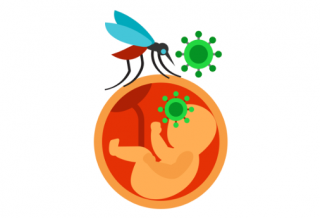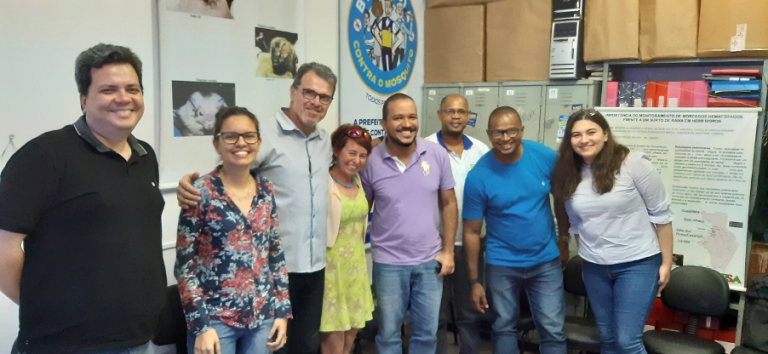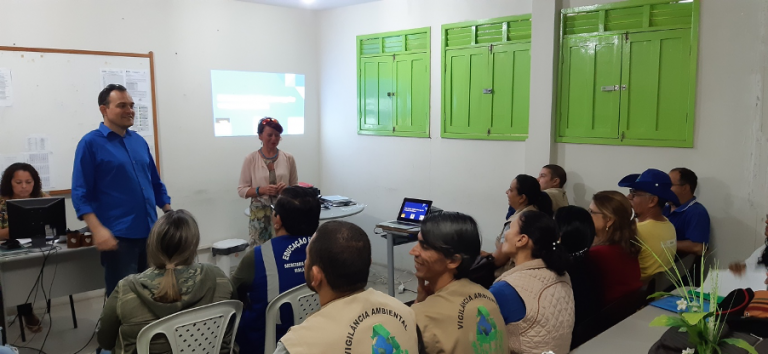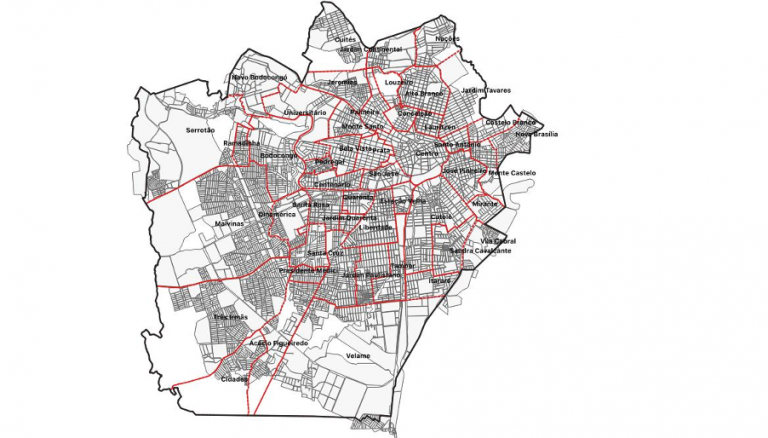The challenge for rapid surveillance and early warning detection of deadly mosquito-borne arboviruses.

Mosquitoes such as the Aedes species (e.g. Aedes Aegypti and Aedes Albopictus) are the natural carriers of the arboviruses which are deadly humans. These vectors are known for transmitting several viruses to humans including Zika, Dengue, Yellow Fever and Chikungunya virus. The Aedes species in particular are native to tropical and sub-tropical regions in the Global South (i.e. South America, Africa, Middle East & South East Asia) and prefer habitats that are close to human dwellings. It should be noted that where these vectors remain native to an area – these deadly viruses, in turn, also remain endemic posing a huge public health concern for humans at risk of exposure.
In the context of Brazil – both the Aedes species exist, and the increased population of these ill-defined vectors are responsible for the raise in health burden of Dengue and Chikungunya. In 2016, the country – especially in the north east – was impacted by the Zika virus epidemic causing severe morbidity and deaths in adults as well as congenital anomalies in unborn children resulting in a birth defect known as microcephaly.
Right now, the Brazilian health authorities are actively working on preventing the spread of arboviruses and eliminating the vector. For instance, the environmental health authorities in cities of Recife (State of Pernambuco) and Campina Grande (State of Paraiba) carry out rigorous surveillance campaign six times per year visiting many households across several neighbourhoods to in order treat infested properties and destroy breeding habitats. However, the existing system suffers from paucity of spatially-referenced household surveillance data rich with urban and environmental characteristics – this is attributed to the current paper-based approach used by fieldworkers for collecting data, which ultimately becomes prohibitively time-consuming to collate and transform into an electronic format if need surveillance analytics.
The existing system needs strong improvements and enhancements for automatic dissemination for the early detection for mosquito populations and levels of household infestation in Brazil. To this end, researchers from Federal University of Pernambuco (Recife, Brazil) & Federal University of Campina Grande (Campina Grande, Brazil) are working closely with the UCL’s Centre for Digital Public Health & Emergencies (DPHE) team to develop a new and innovative system for assisting these environmental agents and managers, as well as health scientists, in the identification of human settlements that pose a significant risk of becoming a hotspot for mosquito breeding in Brazil.
Aims and objectives
The goal is to develop an app that will support the rapid collection and surveillance efforts of mosquito-borne arboviruses in two cites: Recife and Campina Grande.
This innovative tool features two components that work in tandem with each other:
- The first being an agent’s app built for the smartphone which is dedicated to serve as an efficient system for the rapid collection of mosquito surveillance data directly from the field
- The second being an interactive dashboard built for the PC which is designed as a web-GIS based decision support system to aid managers in the automatic allocation of houses to agents for surveying, as well as providing managers maps and charts for the early warning notification of mosquito hotspots in real-time.
The overarching vision for this system is to be implemented in a real-world setting in Brazil where transmission of mosquito-borne diseases is problematic. This novel surveillance system brings together different sources of data ranging from as epidemiological, entomological, household characteristics and spatial information collated seamlessly through the agent’s app into a big database. This rich information, in turn, will be used by the managers and stakeholders to make current & future predictions in real-time of the potential areas at significant risk of increased mosquito population.
Research activities, engagement and outputs
- Focus groups and evaluation of app in Brazil
In August/September 2019, a prototype of the platform is currently being piloted in a 2-month evaluation in Recife and Campina Grande. It has already passed the initial phases and received excellent feedback and critical appraisal from agents, managers and stakeholders from the health ministry through a series of focus groups.

Figure 1: (From left) UCL Researchers PI Prof. Patty Kostkova (fourth) and Georgiana Birjovanu (eighth) were in Recife (Brazil) with Co-I Prof. Wellington P. dos Santos (First) and postdoc researcher Clarrise Lima (second). They are working closely with Public health officers, environmental managers and agents at the Environmental Health Agency in Recife. This picture was taken after delivering a focus group on the showcased web and mobile phone app.

Figure 2: (From left) Co-I Prof. Tiago Massoni and PI Prof. Patty Kostkova are with managers at the Environmental Health Agency in Campina Grande showcasing the web application for monitoring health worker’s progressing in surveillance of mosquitoes in residential areas.
While the platform is currently implemented in two small cities, its technical capabilities are excellent allowing for scalability for increased coverage for surveillance since the technology behind the stack – backend on the server (i.e. Heroku) and database allows for this service. This system will therefore be able to provide critical support for all agents, stakeholders and managers in resource management for treating human dwellings impacted by mosquitoes.
- Best innovation in research @DPH2019 Conference
In November 2019, at the International Digital Public Health 2019 Conference in Marseille – DPHE researcher and app developer, Georgiana Birjovanu, won the runner-up for the best innovation in research. Her presentation was titled: “The ZIKA platform: an innovative system for the real-time surveillance & early detection of increased mosquito populations in Brazil”
For the full story, check out our blog: https://tinyurl.com/yca6ds7k
- List of publications
There are three peer-reviewed articles ranging from extreme online machine learning and geostatistical modelling techniques applied to historical mosquito-borne surveillance data shared by the Environmental health agency in Recife and Laboratório de Imunopatologia Keizo Asami (LIKA) in Federal University of Pernambuco.
Beltran JD, Boscor A, dos Santos WP, Massoni T, Kostkova P. 2018. ZIKA: A new system to empower health workers and local communities to improve surveillance protocols by E-learning and to forecast Zika virus in real-time in Brazil. In Proceedings of the 2018 International Conference in Digital Health. ACM, 90-94. DOI: 10.1145/3194658.3194683
Rubio-Solis A, Musah A, dos Santos W.P, Massoni T, Birjovanu G, Kostkova P. 2019. ZIKA Virus: Prediction of Aedes mosquito larvae occurrence in Recife (Brazil) using online extreme learning machine and neural networks. Proceedings of the 9th International Conference on Digital Public Health – DPH2019. ACM Press. DOI: 10.1145/3357729.3357738
Musah A, Rubio-Solis A, Birjovanu G, dos Santos W.P, Massoni T, Kostkova P. 2019. Assessing the relationship between various climate risk factors & mosquito abundance in Recife, Brazil. Proceedings of the 9th International Conference on Digital Public Health – DPH2019. ACM Press. DOI: 10.1145/3357729.3357744
- UCL Mapathon: Mapping of residential areas for mosquito surveillance in Campina Grande
In Campina Grande, the health agents rely on scanned maps to conduct their campaign of visits for treating infested households and destroying habitats. As the area remains of off-the-grid there is no way to map the spatial distribution of these mosquitoes. Therefore, in January 2020, the DPHE team worked with Dr Sarah Wise from UCL CASA and the British Red Cross’ expert Katherine Robert-Hill and Jiumei Geo, we delivered a GIS workshop to generate digital surveillance maps for one of the study sites at Campina Grande. These were created to support the mapping and surveillance effort in such areas as the they currently rely on scanned maps but have no way of quantifying the spatial distribution of residential areas infested with mosquitoes.

Figure 3: Map of Campina Grande – one of the study sites. We are able to digitise all scanned maps during this event. The city comprises of 47 neighbourhoods containing a total of 4,787 residential block areas.
For the full story, check out our blog: https://tinyurl.com/y6vlycaf
Further Funding from Belmont Forum
Due to the success of this project, the DPHE secured funding of value of £507,684 (NE/T013664/1) to conduct further research on the impacts of climate change on mosquito populations in Brazil. The project is titled: Mosquito population modelling for early warning system and rapid public response by health authorities (MEWAR)
The MEWAR is a trans-interdisciplinary project which will to bring together digital public health, computer sciences, urban water/waste sanitation treatment technologies, meteorology and climate modelling to one arena in order to evaluate the impacts of broader climatic and environmental changes on breeding habitats for mosquito-borne arboviruses in Northeast Brazil. This project will be an international consortium bringing onboard renowned academics from Brazil, Turkey and the United Kingdom.
Project Dates: 1st April 2019 to 31st May 2020
Principal Investigator in the United Kingdom:
Professor Patty Kostkova, Centre for Digital Public Health & Emergencies, Institute for Risk and Disaster Reduction (UCL)
Principal Investigator in Brazil:
Professor Wellington Pinheiro dos Santos, Department of Biomedical Engineering, Federal University of Pernambuco
Co-Investigator in Brazil:
Professor Tiago Massoni, Department of Systems & Computing, Federal University of Campina Grande
Researchers:
Aisha Aldosery (PhD Student), Centre for Digital Public Health & Emergencies, Institute for Risk and Disaster Reduction (UCL)
Dr Adrian Rubio-Solis, Centre for Engineering & Industrial Development, CIDESI Mexico
Dr Anwar Musah, Centre for Digital Public Health & Emergencies, Institute for Risk and Disaster Reduction (UCL)
Georgiana Birjovanu, Centre for Digital Public Health & Emergencies, Institute for Risk and Disaster Reduction (UCL)
Grant Details:
British Council Newton Fund (Reference number: 280860230)
UKRI ESPRC IAA (Reference number: EP/R511638/1)
Click here for more information about the Centre for Digital Public Health in Emergencies (dPHE).
List of ongoing (or past) dPHE projects:
- GASDA – A Gamified Antimicrobial Stewardship (AMS) Decision Support App
- MANTRA – Maternal & Child Health Resilience before, during and after Disasters using Mobile Technology in Nepal
- Mosquito population modelling for early warning system and rapid public response by health authorities (MEWAR)
Follow us on twitter: @UCL_dPHE
 Close
Close

